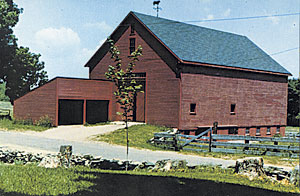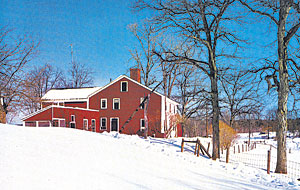The Whittier Family Homestead & Birthplace of the Quaker Poet
 Located on its original site, the Birthplace is substantially the same as when the Poet lived there. 
The present barn, of the same size and style as the original, was moved from a nearby location in 1971.  Many settings described in Whittier’s poems are still recognizable at the Birthplace today. |
In 1688, in a small pleasant valley under the shoulder of Job’s Hill, Thomas Whittier built the house which was to be the Whittier family home. The family lived there for five generations, and it was the Birthplace of the Quaker Poet and Abolitionist John Greenleaf Whittier on December 17, 1807.
The Whittier Birthplace, located on its original site, is an outstanding example of an old New England farm. It is substantially the same as when the Poet lived there from 1807 to 1836. The Birthplace is the setting of his most famous and beloved poem Snow-Bound. Many settings from his poems are recognizable to those who have read them.
| Download brochure |
Outside still stand a bridle-post where horses would be hitched, the natural stone mounting-block used by generations of children, and the doorstone of which the “barefoot boy” ate from his bowl of milk and bread.
The original barn, built in 1821 by John and Moses Whittier, the poet’s father and uncle, was burned in 1970. The present barn, of the same size and style, was moved from a nearby location in 1971.
Fernside Brook still flows along, and the path over the stepping stones to Job’s Hill, the site of the old mill and the ancient family burial lot are to be found within 69 acres of the present Homestead property. The surrounding land inspired Whittier to write such poems as Fernside Brook, Telling the Bees, and the Barefoot Boy, with specific locations so accurately described that they may still be readily identified today.
The Birthplace was formally opened in 1893 after former-Mayor James H. Carleton purchased the house and land and presented it to the Haverhill Whittier Club. The club established a Board of Trustees which to this day holds the deed in trust, with the intent and obligation that the house and grounds be maintained for visitors that the love and memory of Whittier might forever be cherished.